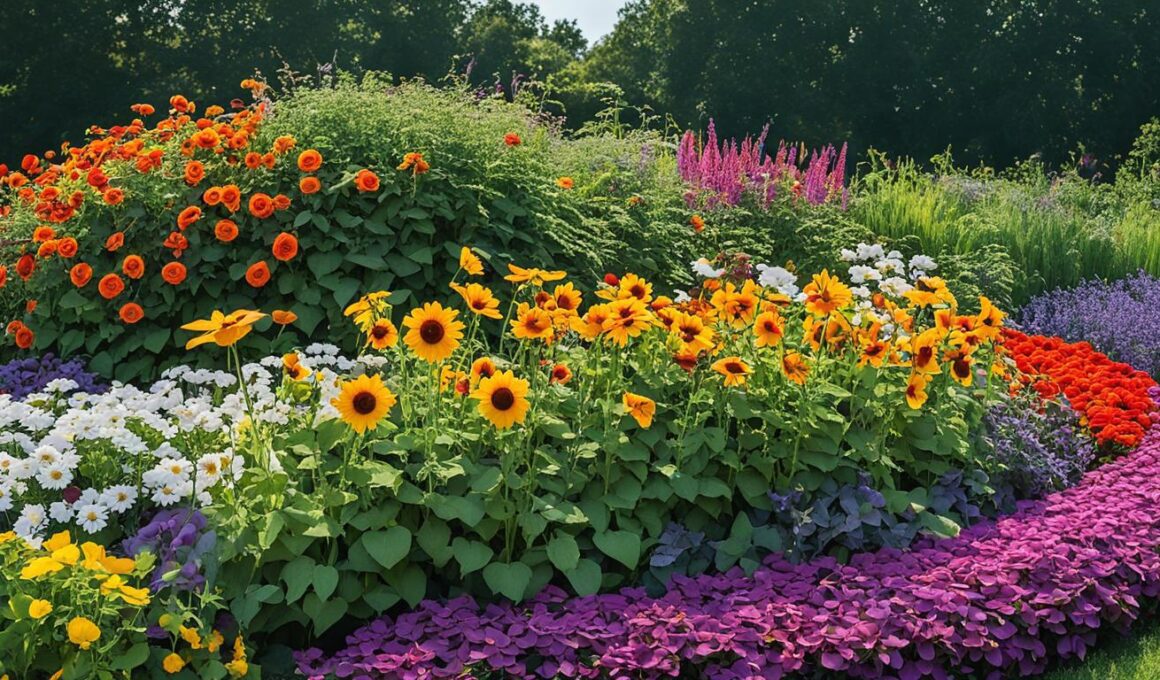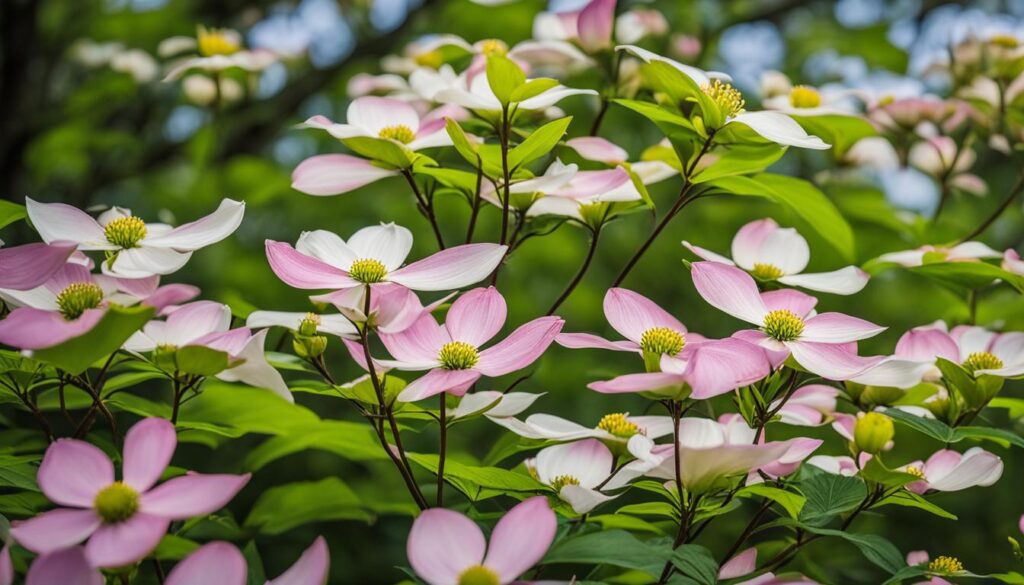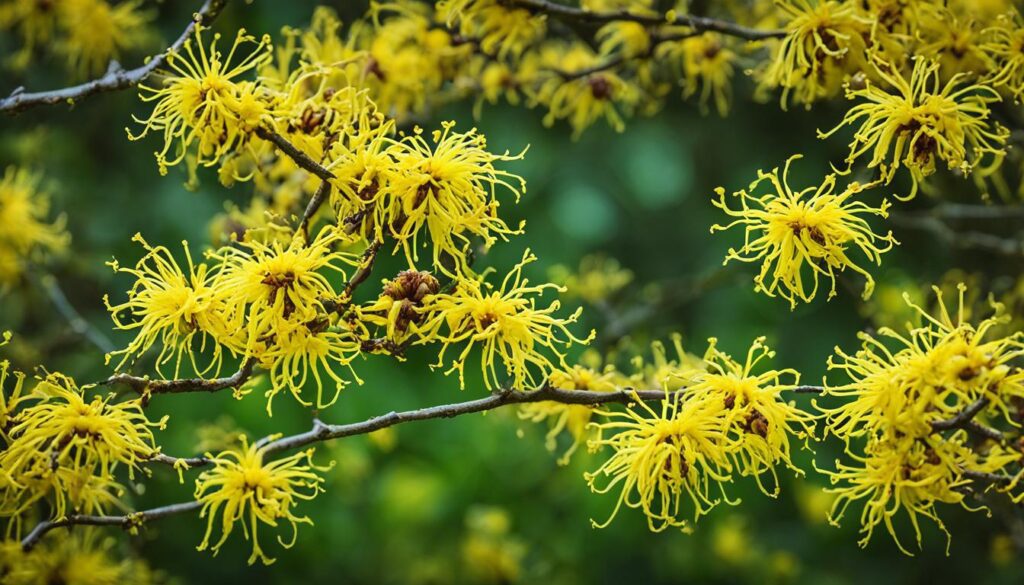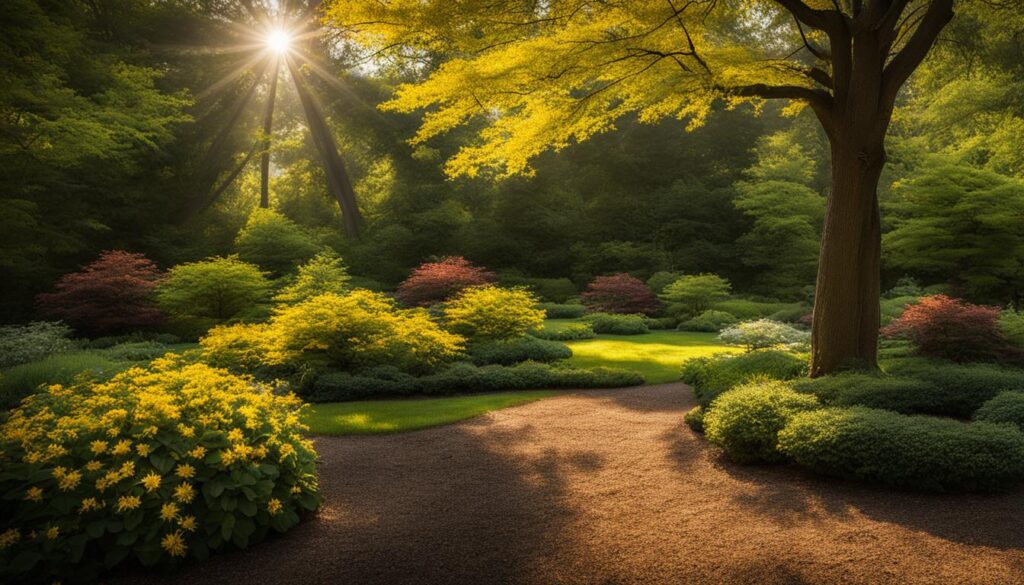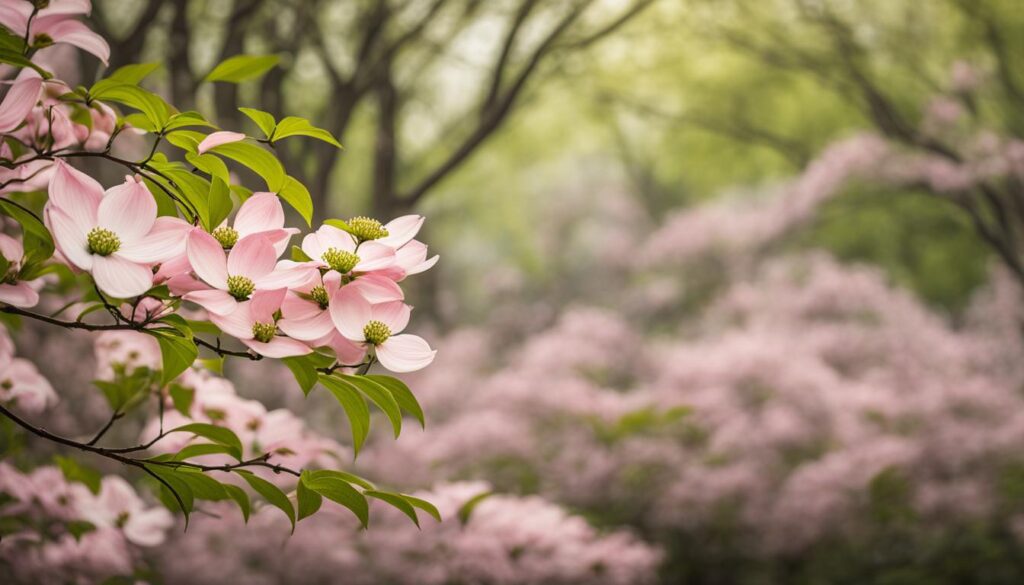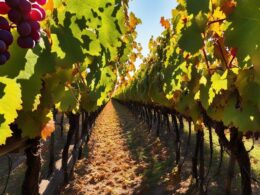Immerse yourself in the creation of vibrant Delaware gardens by selecting the best garden flowers that meld seamlessly with the regional adaptability in plants. Delaware’s verdant landscape, adorned with a plethora of indigenous plants, not only makes your garden visually striking but is also a haven for local wildlife. These hardy native species require minimal upkeep, easily thriving on rainfall alone and warding off common garden afflictions with their inherent resilience.
Whether you’re an experienced horticulturist or a green-thumbed novice, you’ll find that Delaware’s diverse flora offers a low-maintenance yet aesthetically delightful palette to enhance your outdoor sanctuary. Transform your gardening dreams into reality, and let your space be a reflection of Delaware’s natural splendor.
Discovering Delaware’s Native Floral Splendor
As you explore the native wonders of Delaware’s countryside, you are likely to be enchanted by a floral tapestry that stitches itself across the landscape. The native floral splendor of this region, with its unique blooms and scents, paints a living portrait of nature’s artistry. Celebrated among these are the Delaware dogwood beauty, dwarf fringe trees, and swamp azaleas, each contributing their own allure to this botanical mosaic.
Embrace the Beauty of Dogwood
Delaware’s spring canvas is dominated by the Delaware dogwood beauty, an emblematic presence that swathes the region in a cascade of white or pink. The dogwood’s pointillist blooms dot forest edges and clearings, drawing your eye to the awakening splendor of the season. As fall approaches, they trade their blossoms for a fiery red foliage, a sign that Mother Nature remains an unrivaled artist.
Dwarf Fringe Trees: A Fairytale Bloom
If there’s a plant that appears to have leaped from the pages of a storybook, it’s the dwarf fringe tree. These delicate beings enchant with feathery white blooms that seem to float like clouds against a clear blue sky. Invite them into your garden, and they’ll weave a fairytale spell among greener companions, offering an ethereal counterpart to more common foliage.
The Enchantment of Swamp Azaleas
Among the tapestry of Delaware’s native plants is the swamp azaleas allure. A spectacle to behold and fragrance to intoxicate, the swamp azalea cloaks itself in vibrant hues, drawing a kaleidoscope of life. Butterflies dance and birds sing amidst its blossoms, lured by the siren call of red fruits and the intoxicating perfume that lingers in the air.
Best Flowers To Plant In Delaware: A Local’s Guide
If you are looking to enrich your outdoor space with vibrant blooms that reflect the unique beauty of Delaware, turning to a Delaware gardening guide can lead you to a constellation of flower options. This regional guide ties together a plethora of best garden flowers that not only withstand the local climate with finesse but also add captivating layers of color to your garden throughout the seasons.
Delaware’s mild climate and nurturing soil conditions create the perfect setting for native flowers that can elevate the aesthetic of any garden. Adhering to regional gardening tips can be a game changer, especially when you consider Witch Hazel (Hamamelis virginiana)—a favorite of the Delaware Nursery and Landscape Association. This unique shrub dazzles with its bright, confetti-like yellow blooms that punctuate the wintry Delaware landscape with a burst of unexpected beauty.
- Consider the Witch Hazel’s late bloom—from October to December—which provides a visual interest even in the cold months when most plants have retired their colors.
- It flourishes in both full sun and partial shade, accommodating various garden contexts.
- The requirement for moist, well-drained soil makes it well-suited for Delaware’s natural landscape.
- With a potential to mature to a grand size of 10 to 20 feet, it contributes a notable presence to your garden aesthetic.
Adding Witch Hazel to your garden not only embeds vibrant yellow tones into the existing green tapestry but also aligns with a gardening approach that embraces low-maintenance care for full-scale rewards. Let the Witch Hazel’s intriguing form inspire your next garden project, and infuse your surroundings with the brilliant character of one of Delaware’s most beloved woody plants.
Creating Layers in Your Garden with Delaware’s Diverse Flora
Envision a garden where every layer reveals a new chapter in Delaware’s horticultural story. You have the power to sculpt your garden into a multilayered paradise using the diverse Delaware flora. Trees that anchor the sky, shrubs that sculpt the midground, ground covers that carpet the earth, and wildflowers that sprinkle the palette with vivid hues—all coming together to form a living, breathing tapestry.
Creating such a layered garden design not only nourishes the local ecosystem but provides a flourishing display throughout the year. Imagine starting with the foundation of your garden spectacle—the majestic trees that offer shelter and structure, followed by the enchanting shrubs that add density and depth.
Choosing the Right Plant Combination
Your journey into garden layering begins with selecting the right combination of plants. Sweet Goldenrod, with its enticing aroma, will attract pollinators as a ground cover, while the resolute Swamp Milkweed stands steadfast in wet areas. The synergy of these plant selections encourages biodiversity and enriches the garden aesthetics with a lively interaction between the various species.
The Secret Ingredient: Texture and Color
The diverse Delaware flora provides an array of plant textures and colors that are the secret ingredients to your layered design. The interplay of glossy leaves, feathery flowers, and sturdy branches is visually stimulating and impacts the overall feel of your garden. Textural contrasts such as these are the nuances that turn ordinary gardens into extraordinary outdoor retreats. Each choice reflects the natural beauty around you, promising a diverse, resilient garden scene.
By intertwining these elements, your landscape will become a dynamic display of garden aesthetics, where every level sings in harmony with the next. This is the essence of a garden that not only blooms with life but also narrates the story of Delaware’s rich and verdant heritage through its layered garden design.
The Charm and Benefits of Witch Hazel
As you contemplate adding charming garden shrubs to your green space, consider the Witch Hazel—a Delaware-native plant revered for its unique visual appeal and practical attributes. Beyond its delightful presence as a garden staple, Witch Hazel benefits extend into natural remedies for everyday skincare.
This perennial is not just an ordinary plant; it’s a testament to the resilient and adaptable nature of Delaware’s native flora. Witch Hazel’s bursts of bright yellow blooms cheer up even the sleepiest of winter gardens, gracing the landscape when most other plants have bid farewell to their vibrant colors.
- Witness the late-season charm as Witch Hazel flowers from October to December, a period when gardens typically lack color.
- It thrives in both full sun and partial shade, proving its versatility in varied light conditions.
- The Witch Hazel tree can grow to an impressive size, reaching up to 20 feet tall, transforming any ordinary garden into an extraordinary one with its grandeur.
- Adaptable to a spectrum of soil types, it asks for little yet gives so much, requiring minimal maintenance for maximum visual impact.
Consider integrating Witch Hazel into your garden, and you’ll gift yourself not only a stunning anchor for the winter months but also a boost to your home’s natural aesthetic. Its presence makes it a standout among charming garden shrubs, ensuring that your retreat remains a source of joy and beauty year-round.
Seasonal Showstoppers: Flowering Dogwood for Spring Brilliance
As you plan your Delaware spring blooms, consider the flowering Dogwood—a perennial symbol of the state’s natural splendor. This tree emerges as a seasonal showstopper, commanding attention with its flowering Dogwood brilliance. Its enchanting green flowers, nestled within expansive bracts of white or pink, signal the arrival of spring, transforming your garden into an exhibition of nature’s finest art.
The allure of the Flowering Dogwood goes beyond its springtime show. With summer’s warmth, it contributes to a nourishing habitat, serving up crimson berries to local birds like cardinals and mockingbirds. Witness the seasonal transformation as your garden hosts a bustling café for feathered guests, offering respite and sustenance amidst your floral arrangements.
As autumn drapes your garden in a tapestry of change, the Flowering Dogwood once again steps into the spotlight. Prepare for a display of fiery red leaves, a visual encore that solidifies this arboreal wonder as a true year-round centerpiece. Its low-maintenance, once firmly established, rewards you with bountiful color and ecological harmony, creating an outdoor sanctuary to enjoy irrespective of the season.
- Cherish the first hints of spring with Dogwood’s shy blooms.
- Enjoy the summer rustle as birds feast on Dogwood’s red berries.
- Be captivated by autumn’s brilliant foliage, signaling seasonal shifts.
By choosing the Dogwood for your Delaware landscape, you not only invite the bursts of color that herald spring but create a living allegory to nature’s rhythm. Engage in the annual performance of these seasonal showstoppers, and let the flowering Dogwood brilliance become the focal point of your garden’s narrative.
Sweet Goldenrod: Delaware’s Official State Herb
When you’ve got something as special as Sweet Goldenrod, the proud Delaware state herb, in your garden, you’re not just beautifying your space—you’re planting a piece of local heritage. This standout native isn’t just about pretty faces; it’s steeped in utility, wafting through your garden with a licorice-scented breeze, its leaves and flowers brewing into a remedial tea known for medicinal benefits.
Commonly sighted along Delaware’s scenic views, this hardy herbaceous perennial comes alive from mid-summer to fall, presenting vibrant yellow flower clusters. Let’s delve into the dual appeal of Sweet Goldenrod that brings both fragrant charm and ecological vitality to your garden.
A Herbal Delight with Fragrant Leaves
Your senses are in for a treat with this pollinator-friendly native. Imagine stepping out into your garden to be greeted by the anise-like aroma of Sweet Goldenrod; its fragrant leaves remind you why Delaware holds this plant in such high esteem. Their scent is an open invitation not only to your olfactory senses but also to the versatile use as a herbal concoction, promising a natural retreat right in your backyard.
Nature’s Buffet: Attracting Pollinators with Bright Blooms
Here’s a sight to delight any gardener’s heart: a busy throng of bees, butterflies, and hummingbirds joyfully circling the Sweet Goldenrod. These bright blooms are not just visually arresting; they’re also an essential food source for these vital garden visitors. By planting Sweet Goldenrod, you are crafting a pollinator-friendly oasis that buzzes with life, fostering a vibrant ecosystem that thrives year after year.
- Enjoy late-season beauty with luminous yellow flowers that last from July to October.
- Transform your garden into a pollinator haven, full of bees, butterflies, and birds that add life and motion.
- Engage in eco-conscious gardening by integrating this robust, low-maintenance herb that aligns with Delaware’s natural landscape.
In your quest for a garden that mirrors the rustic beauty of Delaware, look no further than the Sweet Goldenrod. Plant this esteemed state herb, and watch your garden turn into a bustling hotspot for pollinators and a serene nook for your leisurely enjoyment.
Pink to Purple Palette: Swamp Milkweed’s Role in Garden Vitality
Immerse yourself in the burst of colors brought by the resilient swamp milkweed, a beacon of garden vitality amid the Delaware wetland flora. This robust perennial adds a vibrant spectrum of pink to purple garden plants, painting your landscape with shades that dance between the warmth of summer and the coolness of fall. Here’s why swamp milkweed should be a cornerstone in your garden:
Adored by the monarch and queen butterflies, this wetland wonder is much more than a picturesque plant; it plays an essential part in sustaining your garden’s ecosystem. The presence of swamp milkweed encourages a flurry of pollinator activity, essential for the health and reproduction of many plants.
- Thrives in moist conditions typical of Delaware’s varied landscape, swamp milkweed is a testament to adaptability.
- The plant’s ability to provide sustenance and refuge to an array of insects makes it a year-round hero for local biodiversity.
- Swamp milkweed’s blooms don’t just charm the eye; they emit a fragrance that captures the essence of Delaware’s outdoor splendor.
By incorporating swamp milkweed into your garden, you invite the many layers of nature’s tapestry into your own backyard. Its resilient nature means it stands undaunted in places where other plants might falter, and its visual appeal maintains a connection to the natural wetlands of Delaware.
Whether tucked into a water garden, gracing the edges of a pond, or bolstering a rain garden, swamp milkweed infuses your living landscape with dynamic life. Embrace this essential member of the Delaware wetland flora and watch as your garden transitions into a hub of activity and beauty, perfectly adapted to Delaware’s ecosystems.
Accentuating Spaces with Arrowwood ‘Eskimo’
Introducing the Arrowwood ‘Eskimo’ to your Delaware garden is an effortless way to add structure and beauty to your outdoor haven. This small garden shrub is recognized for its compact form and easy integration into diverse garden spaces. With its lush dark green foliage and enchanting clusters of white, snowball-like flowers, the Arrowwood ‘Eskimo’ starts its show in early May—just in time to announce the vitality of spring.
Despite its sensitivity to colder temperatures, the Arrowwood ‘Eskimo’ is versatile enough to flourish beautifully in well-drained soils or even large containers, making it a perfect match for Delaware’s moderate climate. It’s particularly well-suited for those smaller gardens where space is at a premium but impact is desired.
- Enhances small garden shrubs’ visibility with its vibrant white blooms and rich foliage.
- Ideal for adding Delaware plant accents in both residential and commercial landscapes.
- Serves as a standout piece, especially when utilized as a low hedge or border—adding depth and texture.
- Its restrained growth habit minimizes the need for frequent pruning.
When planning your garden, imagine how the Arrowwood ‘Eskimo’ can elevate the overall design. It’s not just about its immediate visual appeal, but its ability to maintain rich, green foliage that persists beyond the blooming period, keeping your garden a source of beauty all through the growing season. Whether contained within a pot on your patio or planted as a series of hedges along a walkway, this shrub is the ideal candidate when considering Delaware plant accents for your outdoor space.
The Evergreen Elegance of Eastern Redcedar
Amid the changing seasons, the evergreen elegance of the Eastern Redcedar has a constant presence in Delaware’s landscape. Standing tall and proud, this resilient evergreen becomes a year-round tapestry of green, providing a home and sustenance for a diversity of wildlife. As a Delaware native evergreen, the Eastern Redcedar is well-adapted to the local climate, enduring a range of soil conditions and weather extremes from scorching summers to frosty winters.
Adopting the Eastern Redcedar into your landscape serves a multifaceted role. Not only does it showcase natural beauty, but it also functions as a practical Delaware native evergreen. Its dense foliage and pyramidal form act as a windbreak, offering protection against harsh winds. Yet, its utility in landscaping must be balanced with care, as this tree’s higher flammability requires thoughtful placement away from structures and careful selection in fire-prone regions.
Your embrace of the Eastern Redcedar stands as a testament to making choices that harmonize with Delaware’s environment. By opting for native species like the Eastern Redcedar, you choose plants that require less maintenance and provide more ecological benefits, ensuring that your garden contributes positively to the surrounding ecosystem. Let the rugged beauty of Eastern Redcedar embody the spirit of your garden, embracing the resilience and evergreen elegance that is characteristic of Delaware’s natural heritage.
Can the Same Flowers Thrive in Both Delaware and California Gardens?
Yes, the top flowers for California gardens can thrive in both Delaware and California gardens. These flowers, such as lavender, hibiscus, and yarrow, are well-suited to the climate and soil conditions of both regions. With proper care, these beautiful blooms can flourish in a variety of garden settings.





